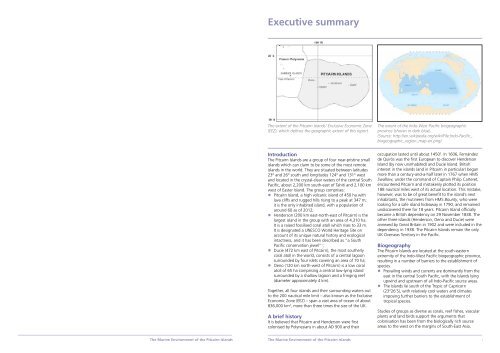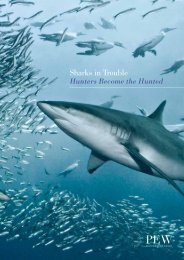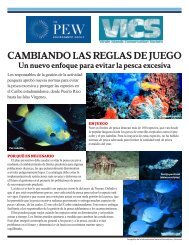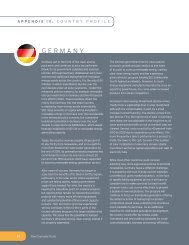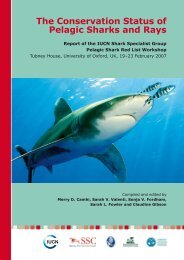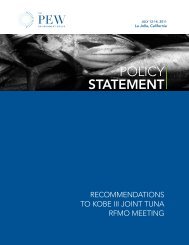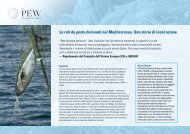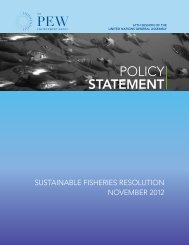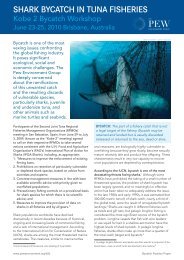The Marine Environment of the Pitcairn Islands - Pew Environment ...
The Marine Environment of the Pitcairn Islands - Pew Environment ...
The Marine Environment of the Pitcairn Islands - Pew Environment ...
Create successful ePaper yourself
Turn your PDF publications into a flip-book with our unique Google optimized e-Paper software.
Executive summary<br />
<strong>The</strong> extent <strong>of</strong> <strong>the</strong> <strong>Pitcairn</strong> <strong>Islands</strong>’ Exclusive Economic Zone<br />
(EEZ), which defines <strong>the</strong> geographic extent <strong>of</strong> this report.<br />
Introduction<br />
<strong>The</strong> <strong>Pitcairn</strong> <strong>Islands</strong> are a group <strong>of</strong> four near-pristine small<br />
islands which can claim to be some <strong>of</strong> <strong>the</strong> most remote<br />
islands in <strong>the</strong> world. <strong>The</strong>y are situated between latitudes<br />
23° and 26° south and longitudes 124° and 131° west<br />
and located in <strong>the</strong> crystal-clear waters <strong>of</strong> <strong>the</strong> central South<br />
Pacific, about 2,200 km south-east <strong>of</strong> Tahiti and 2,100 km<br />
west <strong>of</strong> Easter Island. <strong>The</strong> group comprises:<br />
l <strong>Pitcairn</strong> Island, a high volcanic island <strong>of</strong> 450 ha with<br />
lava cliffs and rugged hills rising to a peak at 347 m;<br />
it is <strong>the</strong> only inhabited island, with a population <strong>of</strong><br />
around 60 as <strong>of</strong> 2012;<br />
l Henderson (200 km east-north-east <strong>of</strong> <strong>Pitcairn</strong>) is <strong>the</strong><br />
largest island in <strong>the</strong> group with an area <strong>of</strong> 4,310 ha.<br />
It is a raised fossilised coral atoll which rises to 33 m.<br />
It is designated a UNESCO World Heritage Site on<br />
account <strong>of</strong> its unique natural history and ecological<br />
intactness, and it has been described as “a South<br />
Pacific conservation jewel” 1 ;<br />
l Ducie (472 km east <strong>of</strong> <strong>Pitcairn</strong>), <strong>the</strong> most sou<strong>the</strong>rly<br />
coral atoll in <strong>the</strong> world, consists <strong>of</strong> a central lagoon<br />
surrounded by four islets covering an area <strong>of</strong> 70 ha;<br />
l Oeno (120 km north-west <strong>of</strong> <strong>Pitcairn</strong>) is a low coral<br />
atoll <strong>of</strong> 65 ha comprising a central low-lying island<br />
surrounded by a shallow lagoon and a fringing reef<br />
(diameter approximately 4 km).<br />
Toge<strong>the</strong>r, all four islands and <strong>the</strong>ir surrounding waters out<br />
to <strong>the</strong> 200 nautical mile limit – also known as <strong>the</strong> Exclusive<br />
Economic Zone (EEZ) – span a vast area <strong>of</strong> ocean <strong>of</strong> about<br />
836,000 km 2 , more than three times <strong>the</strong> size <strong>of</strong> <strong>the</strong> UK.<br />
A brief history<br />
It is believed that <strong>Pitcairn</strong> and Henderson were first<br />
colonised by Polynesians in about AD 900 and <strong>the</strong>ir<br />
<strong>The</strong> extent <strong>of</strong> <strong>the</strong> Indo-West Pacific biogeographic<br />
province (shown in dark blue).<br />
(Source: http://en.wikipedia.org/wiki/File:Indo-Pacific_<br />
biogeographic_region_map-en.png)<br />
occupation lasted until about 1450 2 . In 1606, Fernández<br />
de Quirós was <strong>the</strong> first European to discover Henderson<br />
Island (by now uninhabited) and Ducie Island. British<br />
interest in <strong>the</strong> islands (and in <strong>Pitcairn</strong> in particular) began<br />
more than a century-and-a-half later in 1767 when HMS<br />
Swallow, under <strong>the</strong> command <strong>of</strong> Captain Philip Carteret,<br />
encountered <strong>Pitcairn</strong> and mistakenly plotted its position<br />
188 nautical miles west <strong>of</strong> its actual location. This mistake,<br />
however, was to be <strong>of</strong> great benefit to <strong>the</strong> island’s next<br />
inhabitants, <strong>the</strong> mutineers from HMS Bounty, who were<br />
looking for a safe island hideaway in 1790, and remained<br />
undiscovered <strong>the</strong>re for 18 years. <strong>Pitcairn</strong> Island <strong>of</strong>ficially<br />
became a British dependency on 29 November 1838. <strong>The</strong><br />
o<strong>the</strong>r three islands (Henderson, Oeno and Ducie) were<br />
annexed by Great Britain in 1902 and were included in <strong>the</strong><br />
dependency in 1938. <strong>The</strong> <strong>Pitcairn</strong> <strong>Islands</strong> remain <strong>the</strong> only<br />
UK Overseas Territory in <strong>the</strong> Pacific.<br />
Biogeography<br />
<strong>The</strong> <strong>Pitcairn</strong> <strong>Islands</strong> are located at <strong>the</strong> south-eastern<br />
extremity <strong>of</strong> <strong>the</strong> Indo-West Pacific biogeographic province,<br />
resulting in a number <strong>of</strong> barriers to <strong>the</strong> establishment <strong>of</strong><br />
species.<br />
l Prevailing winds and currents are dominantly from <strong>the</strong><br />
east in <strong>the</strong> central South Pacific, with <strong>the</strong> <strong>Islands</strong> lying<br />
upwind and upstream <strong>of</strong> all Indo-Pacific source areas.<br />
l <strong>The</strong> <strong>Islands</strong> lie south <strong>of</strong> <strong>the</strong> Tropic <strong>of</strong> Capricorn<br />
(23°26’S), with relatively cool waters and climates<br />
imposing fur<strong>the</strong>r barriers to <strong>the</strong> establishment <strong>of</strong><br />
tropical species.<br />
Studies <strong>of</strong> groups as diverse as corals, reef fishes, vascular<br />
plants and land birds support <strong>the</strong> arguments that<br />
colonisation has been from <strong>the</strong> biologically rich source<br />
areas to <strong>the</strong> west on <strong>the</strong> margins <strong>of</strong> South-East Asia,<br />
<strong>The</strong> <strong>Marine</strong> <strong>Environment</strong> <strong>of</strong> <strong>the</strong> <strong>Pitcairn</strong> <strong>Islands</strong> <strong>The</strong> <strong>Marine</strong> <strong>Environment</strong> <strong>of</strong> <strong>the</strong> <strong>Pitcairn</strong> <strong>Islands</strong><br />
i


